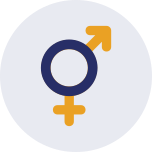IASC Gender Accountability Framework Report 2019
 The 2019 Inter-Agency Standing Committee (IASC) Gender Accountability Framework (AF) report marks the second monitoring cycle of the IASC’s 2017 Gender Equality and the Empowerment of Women and Girls in Humanitarian Action Policy. It provides a snapshot of the IASC’s output in the calendar year 2019 and allows for cross comparison with the baseline established with the 2018 AF report.
The 2019 Inter-Agency Standing Committee (IASC) Gender Accountability Framework (AF) report marks the second monitoring cycle of the IASC’s 2017 Gender Equality and the Empowerment of Women and Girls in Humanitarian Action Policy. It provides a snapshot of the IASC’s output in the calendar year 2019 and allows for cross comparison with the baseline established with the 2018 AF report.
Executive summary
The 2019 Inter-Agency Standing Committee (IASC) Gender Accountability Framework (AF) report marks the second monitoring cycle ofthe IASC’s 2017 Gender Equality and the Empowerment of Women and Girls in Humanitarian Actin Policy. It provides a snapshot of the IASC’s output in the calendar year 2019 and allows for cross comparison with the baseline established with the 2018 AF report. The 2019 report shows some progress and some remaining inconsistencies in the application of the 2017 Gender Policy. At the global level, gender was designated as a strategic priority for the allocation of CERF funding by the Emergency Response Coordinator and the first thematic evaluation by the IASC internal evaluation mechanism – the IAHE – was set as delivery on the gender policy. Both initiatives signifying commitment of the IASC management to address gender in humanitarian action. Progress on the recommendations from the 2018 report has been limited, indicating the need for strengthened ownership of the recommendations by all stakeholders in the process. Across all levels of the IASC, more effort is needed to translate the recommendations into action, with the GRG taking a more active role in their dissemination and providin. At the field level, the analysis shows consistent consideration of protection and GBV for women and girls and the provision of maternal-child health services in all of the Humanitarian Needs Overview documents for the 2020 Humanitarian Program Cycle that were reviewed.
However, there was a drop in the extent of gender analysis that took a more comprehensive view of the impact on women, girls, men and boys, beyond just protectionandmaternalhealth. Acomprehensivegender analysis beyond protection is particularly valuable given that the majority of crises are now protracted, multi-year contexts, and as such it is important to consider what the longer-term needs are, especially with regards to addressing livelihoods and education needs. Utilizing this metric, the report notes that percentage of HNOs employing gender analysis has remained the same (90% in 2018 compared to 89% in 2019). This aligns with findings from the annual Humanitarian Programme Cycle Quality Scoring exercise led by OCHA which also assesses HNOs and HRPs with a different set of indicators, which states specifically that “Gender concerns overall and, notably, an understanding of the risks, vulnerabilities, and coping mechanisms along with causes of inequity – the analysis required for effective programming – continues to be found in only a few HNOs.”
Analysis of the accountability framework’s indicator results demonstrate how the provision of gender capacity and facilitation of women’s voices contribute to better process results. For example, in the country contexts where local women were consulted 92% of them demonstrated the inclusion of a comprehensive gender analysis. Similarly, in the countries that consulted local women, 70% included provisions for the key service lines – GBV mitigation and response, women’s livelihoods and sexual and reproductive health. Where there was no formal consultation with local women, these services were only prioritized in 55% of the context countries. Further research on how these this causality is caused through these process relationships is warranted.
In addition, where the country contexts indicated that they had gender in humanitarian action capacity, 100% utilized gender analysis in HNOs, compared to the 89% average and 73% had the key service lines - GBV mitigation and response, women’s livelihoods and sexual and reproductive health – compared to the 55% average in HRPs. The recommendations from the 2018 report still stand and are included as an annex to this report. A number of additional recommendations for the different strata of the IASC and its field representation are laid out in the relevant report sections.
